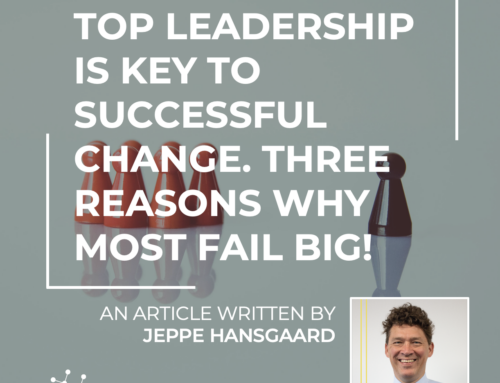FROM OUR CEO
The Scale-Up that ALMOST Failed
October 6th, 2020 | From our CEO

Less than 5% of organizations succeed in scaling above the normal start-up size. The organization described in this post was among the 5%, but then almost failed.
Rapid Growth in Revenue, New Locations Added, External Recognition – A Success Story?
It was successful in all the parameters normally measured by externals.
It had started out as a small partner lead consulting company and then scaled fast in terms of revenue, as they proved their capabilities and credibility with their clients. In the process, they had added one extra location – one hour away from their main office and closer to two new clients, which they hoped to have long-term relationships with. Five years after its establishment the organization totaled 26 people including 4 full-time freelancers.
Everything looked positive, but when you scratched a bit on the surface a different story emerged.
The Story that Emerged Under the Surface
While the partners had started the company as a strong and united team, it was when they grew the problems emerged. The partners were deeply involved in the delivery to clients – and often ignored the necessity for aligning expectations and directions. Often decisions were taken too late or based on limited information.

They had instilled several structural practices to cope with the growing organizational complexity, such as:
- Developed individual incentive schemes – also at partner level – focused on sales and billing
- Outsourced all support processes
- Established delivery functions with strong separate identities to drive specialization
- Engaged freelancers to fill the empty delivery slots
- Optimized onboarding process on time, so the new person could deliver on projects faster
- Build strong control mechanisms for time, sales & expense reporting
But the mood in the office was not as good, as it used to be. Important well-liked and popular colleagues (also by the clients) were resigning. Leaving the company for other opportunities. The struggle to sell enough project services to keep scaling – or even just staying at the same activity level was an issue leading to outspoken conflicts among the partners. Client Satisfaction scores started to decline.
Gather the Evidence Instead of Acting on Gut Feelings
The all had different views of what was going on in the organization.
One of them – the partner that had mostly stayed silent and observed – recommended that they gathered the evidence instead of just acting on gut feelings.
The all had different views of what was going on in the organization.
One of them – the partner that had mostly stayed silent and observed – recommended that they gathered the evidence instead of just acting on gut feelings.
This is where Innovisor got engaged.
To understand how the culture was being lived out? – how happy people where? – how they collaborated and shared knowledge with each other? – If the organization was acting as ONE? – and how agile it was compared to its competitors?

Things were not looking good. The organization was a loosely attached group of individuals – not working together. 25% were totally detached from the informal networks. They did not know the competencies of each other, or even feeling they had access to each other. There was a widespread feeling that everybody was ‘on their own’. The motivation was very low – and the risk of key individuals leaving was high.
The need for change was evident. The partners decided to act!
The Actions Taken to Regain The Bright Future
The actions they decided to take based on the recommendations from Innovisor were:
- Set joint goals for improvement from the baseline and decide when to re-assess
- Engage key employees as a sounding board for all organizational activities
- Re-establish team-based incentive structures
- Acknowledge the need for a shared organizational identity – not at team or location identity. Focus all social activities at this level to create ONE coherent team
- In-source support processes to regain a feeling of flexibility and agility
- Decrease use of freelancers to a maximum of 10% of the workforce
- Formalize the People & Culture responsibility
One year later it was a happier, more coherent, and better performing organization Innovisor was assessing. Stress levels were down and client satisfaction was up. The partners were a team again, and the organization had returned to healthier organizational growth and retained its status as a scale-up.
Other Inspiration
Jeppe Vilstrup Hansgaard: The Danger Zones Where Your Scale-Up Fails
FROM OUR CEO
The Scale-Up that ALMOST Failed
October 6th, 2020 | From our CEO

Less than 5% of organizations succeed in scaling above the normal start-up size. The organization described in this post was among the 5%, but then almost failed.
Rapid Growth in Revenue, New Locations Added, External Recognition – A Success Story?
It was successful in all the parameters normally measured by externals.
It had started out as a small partner lead consulting company and then scaled fast in terms of revenue, as they proved their capabilities and credibility with their clients. In the process, they had added one extra location – one hour away from their main office and closer to two new clients, which they hoped to have long-term relationships with. Five years after its establishment the organization totaled 26 people including 4 full-time freelancers.
Everything looked positive, but when you scratched a bit on the surface a different story emerged.
The Story that Emerged Under the Surface
While the partners had started the company as a strong and united team, it was when they grew the problems emerged. The partners were deeply involved in the delivery to clients – and often ignored the necessity for aligning expectations and directions. Often decisions were taken too late or based on limited information.

They had instilled several structural practices to cope with the growing organizational complexity, such as:
- Developed individual incentive schemes – also at partner level – focused on sales and billing
- Outsourced all support processes
- Established delivery functions with strong separate identities to drive specialization
- Engaged freelancers to fill the empty delivery slots
- Optimized onboarding process on time, so the new person could deliver on projects faster
- Build strong control mechanisms for time, sales & expense reporting
But the mood in the office was not as good, as it used to be. Important well-liked and popular colleagues (also by the clients) were resigning. Leaving the company for other opportunities. The struggle to sell enough project services to keep scaling – or even just staying at the same activity level was an issue leading to outspoken conflicts among the partners. Client Satisfaction scores started to decline.
Gather the Evidence Instead of Acting on Gut Feelings
The all had different views of what was going on in the organization.
One of them – the partner that had mostly stayed silent and observed – recommended that they gathered the evidence instead of just acting on gut feelings.
The all had different views of what was going on in the organization.
One of them – the partner that had mostly stayed silent and observed – recommended that they gathered the evidence instead of just acting on gut feelings.
This is where Innovisor got engaged.
To understand how the culture was being lived out? – how happy people where? – how they collaborated and shared knowledge with each other? – If the organization was acting as ONE? – and how agile it was compared to its competitors?

Things were not looking good. The organization was a loosely attached group of individuals – not working together. 25% were totally detached from the informal networks. They did not know the competencies of each other, or even feeling they had access to each other. There was a widespread feeling that everybody was ‘on their own’. The motivation was very low – and the risk of key individuals leaving was high.
The need for change was evident. The partners decided to act!
The Actions Taken to Regain The Bright Future
The actions they decided to take based on the recommendations from Innovisor were:
- Set joint goals for improvement from the baseline and decide when to re-assess
- Engage key employees as a sounding board for all organizational activities
- Re-establish team-based incentive structures
- Acknowledge the need for a shared organizational identity – not at team or location identity. Focus all social activities at this level to create ONE coherent team
- In-source support processes to regain a feeling of flexibility and agility
- Decrease use of freelancers to a maximum of 10% of the workforce
- Formalize the People & Culture responsibility
One year later it was a happier, more coherent, and better performing organization Innovisor was assessing. Stress levels were down and client satisfaction was up. The partners were a team again, and the organization had returned to healthier organizational growth and retained its status as a scale-up.
Other Inspiration
Jeppe Vilstrup Hansgaard: The Danger Zones Where Your Scale-Up Fails
Related articles
Share article
Share article









